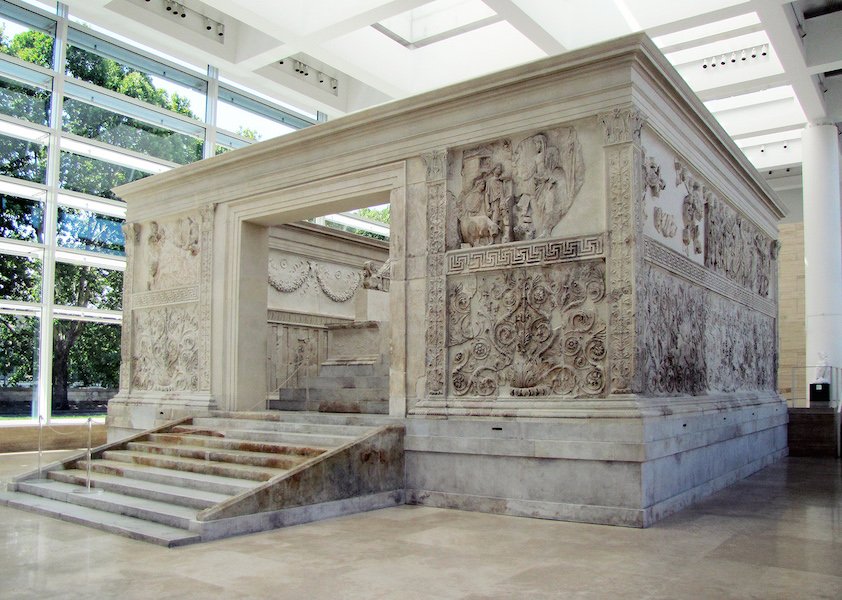Art as Propaganda in The Roman Republic
Today, information is readily available through technology. We can engage with news and articles that enhance our understanding of our nation's leaders, a privilege that has not always been available. Before technology, rulers had to use other means to convey messages to people and raise support for their agendas. This was primarily accomplished through symbolic artwork and architecture.
Figure 1: Augustus of Primaporta, 1st century CE, Marble
A prime example of an artwork used as propaganda is the marble statue Augustus of Primaporta. This sculpture was designed to depict how Augustus wanted to be perceived and how he perceived his reign. He used powerful imagery to communicate his ideology. With Greek influence, the Roman sculpture displays Augustus with an idealistic, young, athletic build with a contrapposto pose. He is displayed in battle gear, pointing to lead troops. His breast place is covered in figures that display the gods' support and military victory (Fischer, 2020). Through the featuring of Cupid, Augustus links himself with Venus, claiming he is also the son of Venus. The most prominent message shown by this stature is the ushering in of Pax Romana, or peace, to the Roman Republic.
Figure 2: The Ara Pacis Auguste (Altar of Augustan Peace), 9 B.C.E
The Ara Pacis Auguste (Altar of Augustan Peace) conveys messages similar to those of the Augustus of Primaporta but through architecture and relief. The Altar of Augustan Peace is modeled after Roman open-air blood sacrifice altars, but it served a purpose. The structure celebrates the restoration of Pax Romana by Augustus, featuring a celebration in relief on one of the walls. The celebration contrasts with other displays of leaders' success because it shows the celebration of the results of military victory, not the military victory itself. This altar also has much religious association, as it is dedicated to the Horologium (sundial) and has mythological reliefs showing fertility symbols, the personification of Rome, and other symbolism, further connecting Augustus with the gods and conveying their support of his endeavors. The Ara Pacis Auguste is another way Augustus displayed his reign in an idealistic way.
Figure 3: Head of Roman Patrician from Otricoli, c 75-50 BCE, Marble
The Head of Roman Patrician is a bust of a male aristocrat meant to convey his devotion to the republic. The aristocrat is displayed as veristic (or hyperrealistic), showing age, contrasting with the idealistic sculptures of Augustus and the Greeks (Becker, 2015). The purpose was to display the marks left by his career and severe mind. He depicted himself in a way that showed he worked hard and had a respectable career. Though this figure is not idealistic, it is still an example of propaganda because it attempts to convey a public figure admirably and convince the public of his virtues.
Figures primarily used art to convey messages, reinforcing their power and gaining admiration from the people. Whether before or after the subject's death, the pieces immortalize the excellence these elite perceived themselves to be and display themselves in a way to provoke a reaction or support from the public.
Cited Sources
Becker, Jeffery A. “Head of a Roman Patrician .” Smart history, August 8, 2015. https://smarthistory.org/head-of-a-roman-patrician/ October 28th, 2024
Fischer, Julia. “Augustus of Primaporta.” Smart History, November 6, 2020. https://smarthistory.org/augustus-of-primaporta/ October 28th, 2024
Hussiani, Ibrahim U, Abbas Sa’id El-Nafaty, Bukar Usman Wakawa , and Aminu Umar. Art AND Architecture As Sustainable Tools of Propaganda: A Brief Review Of The Imperial Rome And Its Influence on The 21st Century Polity, 2024. https://jaas.science-line.com/attachments/article/42/J.Art.Arch.Stud.13(1)1-11,%202024.pdf Accessed October 29th, 2024
Steinfeld, Jemimah. “What the Romans Did for Us: On the Age-Old Art of Propaganda.” Open Democracy, June 16, 2017. https://www.opendemocracy.net/en/digitaliberties/what-romans-did-for-us-on-age-old-art-of-propaganda/ Accessed October 27th, 2024
Stokstad, Marilyn, and Micheal W Cothren. “Etruscan and Roman Art.” Afterward. In Art: A Brief History, 4th ed., 141–50, n.d. Accessed October 27th, 2024
Written by Red Jordanger
Written October 28th, 2024
Electronically Published December 7th, 2024



